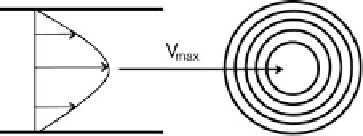Biomedical Engineering Reference
In-Depth Information
Fig. 5 Laminar steady parabolic flow is present in most of the cardiovascular system. The
arterial walls slow the flow down and the maximum velocity is found in the center of the arteries.
Flow is distributed in concentric circles in the diameter of the vessel
5 Fluid Mechanics of the Vasculature
High blood flow as a result of increased large arterial stiffness may induce
abnormal vasoreactivity of the artery, which could lead to the development of
diseases such as pulmonary hypertension [
42
]. Proximal arterial characteristics,
such as stiffness, influence blood spatial and temporal flow patterns in downstream
vessels [
43
]. Elasticity of the upstream arteries determines the flow pattern on
downstream small arteries. The less elastic the upstream pulmonary arteries, the
higher flow pulsations in the small arteries, which normally experience low flow
pulsations [
44
]. Decreased elasticity in the artery could lead to enhanced energy
transmission to the smaller arteries, which could lead to vascular damage. The
major determinants of blood flow are pressure, the viscosity of the blood, and the
elasticity of the vessel.
Normal flow in the pulmonary artery is laminar, which is characterized by
concentric layers of fluid moving parallel through the length of a vessel (Fig.
5
).
The velocity of the fluid is affected by the spatial geometry of the vessel. Fluid
closest to the blood vessel wall is slowest, while it reaches a peak velocity at the
center of the vessel. Thus, steady laminar flow exhibits a parabolic profile across
the width. Pulsatile flow is also laminar, but it is more complicated than steady
flow as its spatial flow profile is a flattened parabola. Figure
6
demonstrates that
near the wall the velocity of pulsations is dampened to near zero flow, while
toward the mid axis of the vessel, the maximum pulse flow velocity is reached.
Therefore, there is a spatial flow gradient across the width of the blood vessel for
both steady and pulsatile flow in the arteries.
5.1 Steady Flow Behavior
Steady flow is described by the Poiseuille equation, which states that the pressure
gradient is directly proportional to the length of a vessel, and to the rate of flow
through the tube, while the viscosity of the liquid is inversely proportional to the
width of the vessel (Fig.
7
). Flow increases exponentially with increases in the
radius.

Search WWH ::

Custom Search